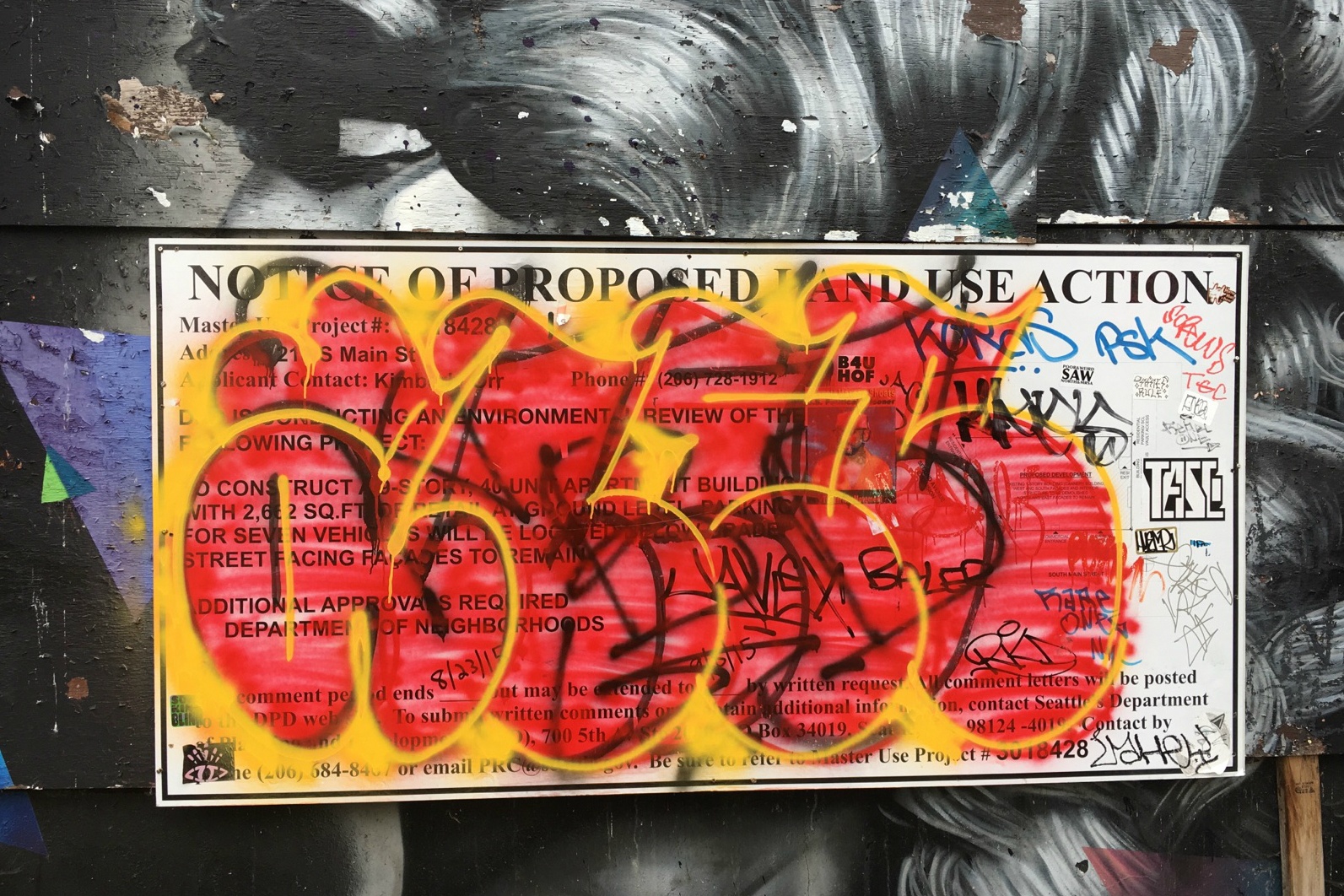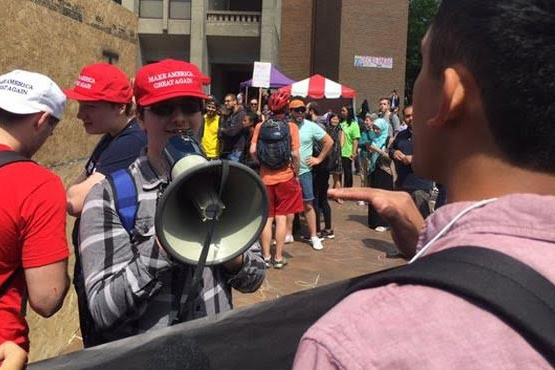They say writing about music is like dancing about architecture, but what about doing graffiti on writing about architecture? Seattle leads the nation in the number of construction cranes dotting its skyline, so it must be near the top in proposed land-use signs, too—those white slabs of plywood festooned with architectural descriptions. And sure enough, writing about architecture makes a juicy target for the area’s tagger subculture.
“I would say 95 percent of all the land-use signs we had to post ended up getting tagged,” estimates Mike Romine, a partner at a local architecture firm for more than 20 years.
The purpose of the signs is straightforward: notify people in the area about what developers want to do and provide them with ways to object or otherwise give feedback. They cost hundreds of dollars to manufacture and are mandated by the city for most new construction, yet rampant tagging makes them all but useless. The function of land-use signs is to inform the neighbors and the community, Romine says; to that end, “the public has to be able to see and read the signs.”
The city knows this, and says it requires developers to clean up any graffiti that lands on their signs. “Applicants are usually very responsive in cleaning off their LUIB [Land-Use Information Bulletin] because it is part of the official public-notice process,” says Wendy Shark, senior public relations specialist for the City of Seattle’s Department of Construction and Inspections.
Anyone who lives and works near a tagged sign should find Stark’s claim dubious; they can go months without a fresh coat of sanctioned municipal-code gobbledygook. “I suspect taggers like land-use signs because they know the graffiti will stay up for weeks or months,” says Ethan Phelps-Goodman of Seattle in Progress, a blog that follows urban development, “whereas a tag on a wall is likely to be removed quickly by the building owner.”
Best Buy, a local tagger, tells me, “I know that it will stay up longer and will be seen by more people than displaying the tag on the building right behind it.” He continues, “It’s like the tagger’s own ad board.”
Not that it really matters, Phelps-Goodman argues. Even untagged, the signs are near-impossible for a layman to understand. As Monica Spain of KNKX understated recently, “The wording on these signs can seem cryptic.” Land-use signs can be seen as just a symbolic gesture to make the public feel included that is then covered up by other symbolic gestures. Says Phelps-Goodman: “The interesting thing to me about graffiti on land-use notices is that the notices are so poorly designed that being covered in graffiti hardly makes them any worse.”
But what, exactly, does the graf symbolize? A widespread hypothesis holds that it protests the growth the signs announce. Kurt Schlosser, author of a September piece on Geekwire about LUIB graffiti, wrote: “I was down in South Lake Union this summer and a land-use sign near Amazon read ‘suck it techie scum,’ and to me that just conveys the overwhelming message that the city is grappling with, and that’s rapid growth and change tied to the tech industry.”
Guerrilla artist John Tingley went a step further than graffiti by setting up five parody LUIB signs in April, which advertised fanciful buildings like “Mixed use condo/retail structure including the first of its kind subterranean Whole Foods/Trader Joe’s connected with the new SR-99 tunnel named Cash Hole Foods.” The five pieces, distributed across Cascade, Capitol Hill, and downtown, were among the few left untagged.
“Some of [the graffiti] is communicative graffiti done by anti-growth NIMBYs,” acknowledges Chris Young, SPD’s full-time graffiti detective. But in line with Best Buy’s comments, Young thinks land-use signs are mostly a “target of opportunity”: fun and easy to tag, and if there’s a political element, that’s fun too.
Several sources support this theory. Phelps-Goodman: “I’ve seen a couple instances of anti-development political messages on land-use signs, but 99 percent of the graffiti is just tagging.” Romine: “Graffiti with any hint of creativity was not something I ever saw on a land-use sign.” Scott Bonjukian of The Urbanist: “The graffiti I see is generally unreadable, so if there’s any message or political point trying to be made, I couldn’t tell you what it is.”
“I think you’re thinking about it too hard,” agrees Best Buy. “Tagging isn’t that complicated to understand. A land-use sign is hardly any different than tagging anything else. It’s a school prank that’s escalated to crime.”
Best Buy says he’s not anti-growth. On development, he is Zen: “It’s cool. Kind of disappointing to see old buildings go, but new construction and more urban landscape in the long run is better for graf.” The land-use signs herald a grander canvas: more buildings! And graffiti is powerless to stop them. The only way it can protest is by doing what it does best, which is nothing. As the bottom of one of Tingley’s parody signs reads, “Resistance is futile.” A slogan for the times.
news@seattleweekly.com






